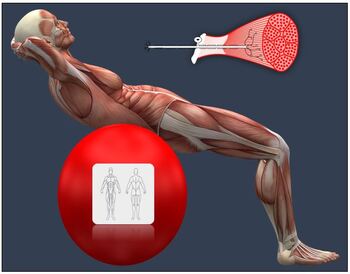Human Anatomy & Physiology Unit 6 Bundle: The Muscular System
- Zip
- Easel Activity
Products in this Bundle (5)
Bonus
Also included in
- Make teaching Anatomy & Physiology super easy with this highly requested anatomy course growing bundle! SIOP, gifted, and differentiation strategies are embedded and easily identified throughout each unit plan. Lessons are differentiated according to learning style, grouping, and language abilPrice $332.80Original Price $446.97Save $114.17
Description
This bundle includes:
- Human Anatomy & Physiology Unit Plan 6: The Muscular System
- Unit 6 Powerpoint: The Skeletal System
- Review Worksheet: Muscle Cell Physiology (Free Resources)
- Lab Activity: Overview of Muscle Tissue (Skeletal, Smooth, and Cardiac)
- Muscle Cell Physiology: A Review Quiz Worksheet
- Case Study: Clinical Case Study: Musculoskeletal Physiology (Free!)
- Lab Activty: Exercise Selection for Major Muscle Groups
- Unit 6 Review Quiz: The Skeletal System (Free bonus file!)
- Unit 6 Test: The Skeletal System (Free bonus file!)
For other great resources to make teaching easier follow me for updates! If you like my product, don't forget to write a review! Thank you!
The Unit Plan
Make teaching Anatomy & Physiology easy with this combined unit and daily lesson plan that covers 2-3 weeks (depending on the number of labs you choose to do) of a secondary A & P course. SIOP, gifted, and differentiation strategies are embedded and easily identified throuought. Lessons are differnetiated accoding to learning style, grouping, and language ability. Both content and literacy standards as well as key vocabulary words, essential questions, activating strategies, instructional strategies, and summarizing strategies are included and highlighted. Video links are provided! (Please note that video links are active but may requires access to United Streaming and/or that you be logged into your google account)
Upon completion of this unit, students will be able to:
Content Standards:
SAP2: Students will analyze the interdependence of the integumentary, skeletal, and muscular systems as these relate the protection, support and movement of the human body.
- Explain how the skeletal structures provide support and protection for tissues, and function together with the muscular system to make movements possible.
SCSh2. Students will use standard safety practices for all classroom laboratory investigations and activities.
- Follow correct procedures for use of scientific apparatus and demonstrate appropriate technique in all laboratory situations.
- Follow correct protocol for identifying and reporting safety problems and violations.
Literacy Standards:
- L11-12RST2: Determine the central ideas of conclusions of a text; summarize complex concepts, processes, or information presented in a text by paragraphing them in simpler but still accurate terms.
- L11-12RST3: Follow precisely a complex multistep procedure when carrying out experiments…
Content Objectives (TSWBAT):
- Describe the structure and function of the three types of muscle tissue and indicate where they are located in the body.
- Define muscular system, explain the role of each of the following: endomysium, perimysium, epimysium, tendon, and aponeurosis.
- Describe the microscopic structure of skeletal muscle and explain the role of actin-myosin myofilaments.
- Describe how an action potential is initiated and its role in muscle contraction.
- Describe the events of muscle contraction.
- Define, compare, and analyze graded responses of skeletal muscle tissue and explain how the terms tetanus, isotonic, isometric contractions and muscle tone apply to skeletal muscle.
- Define oxygen deficit and muscle fatigue, and list possible causes of muscle fatigue.
- Describe the effects of aerobic and resistance exercise on skeletal muscles and other body organs.
- Describe three pathways for ATP production.
- Define origin, insertion, prime mover, antagonist, synergist, and fixator as they relate to muscles and demonstrate different types of body movements.
- List seven criteria used in naming muscles.
- Name and locate the major muscles of the human body.
- Describe common exercises and stretches that target major muscles of the body.
- Describe changes that occur in aging muscles and lifestyle behaviors that address these changes.
- Identify risk factors, treatments, and preventive measures of common muscle disorders and injuries.
Language Objectives:
- Discuss and illustrate the process of neuromuscular contraction.
- Read clinical case studies of homeostatic imbalances of the muscular system.
- Write, discuss, and use key vocabulary appropriately.
Key Vocabulary:muscle fibers, skeletal muscle fibers, striated muscle fibers, voluntary muscle, epimysium, tendon, aponeurosis, smooth muscle, cardiac muscle, myofibrils, light bands, A Bands, I Bands Z Line, myosin, myofilaments, actin, cross bridges, thin filaments, sarcoplasmic reticulum, motor unit, axon, axon terminals, neuromuscular junctions, neurotransmitter, acetylcholine, synaptic cleft, Amyotrophic lateral schlerosis, action potential, graded responses, unfused tetanus, incomplete tetanus, muscle twitches, direct phosphorylation of ADP, Creatine phosphate (FP), Aerobic pathway, aerobic respiration, anaerobic glycolysis, lactic acid, aerobic glycolysis, muscle fatigue, oxygen deficit, isotonic contractions, isometric contractions, muscle tone, flaccid, atrophy, aerobic exercise, aerobic exercise, endurance exercise, resistance exercise, isometric exercise, origin, insertion, flexion, extension, rotation, abduction, adduction, circumduction, dorsiflexion, plantarflexion, inversion, eversion, supination, pronation, opposition, prime mover, antagonists, synergists, fixators, biceps brachii, brachioradialis, buccinators, cardiac muscle, contractibility, deltoid, diaphragm, elasticity, excitability, extensibility, external oblique, hamstrings, gastrocnemius, gluteus maximus, gluteus medius, intercostal muscles, involuntary, latissimus dorsi, masseter, motor unit, muscle fatigue, muscle tone, neuromuscular junction
oxygen debt, rectus femoris, pectoralis major, quadriceps femoris, rectus abdominis, sarcolemma, Sartorius, skeletal muscle, smooth muscle, soleus major, sphincter, sternocleidomastoid, tibialis anterior, trapezius, triceps brachii, vastus lateralis, vastus medialis, voluntary, atrophy , hypertrophy, muscle spasm (cramp), myalgia, strain, tendonitis
I would love to hear from you! I am in the process of uploading related resources. If there is anything you would like to see prioritized, please let me know! If you like my product, don't forget to write a review!
Than you for shopping Best for Teachers!
Check out my EXERCISE AND NUTRITOIN PLANS FOR TEACHERS ON TPT OR VISIT MY WEBSITE AT REVERSAGE HEALTH & FITNESS! Download my free 1 Week sample Vegetarian Meal Plan for a summer jumpstart weight loss cleanse!





